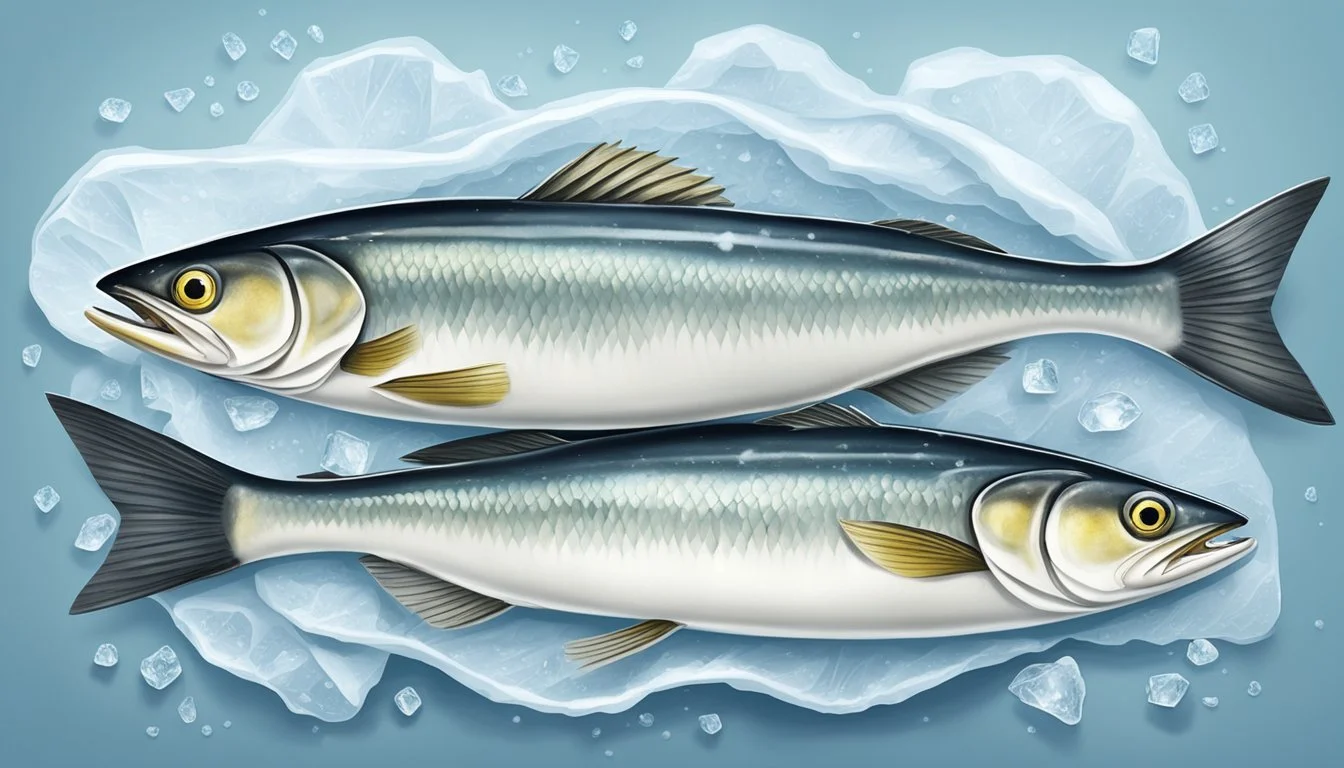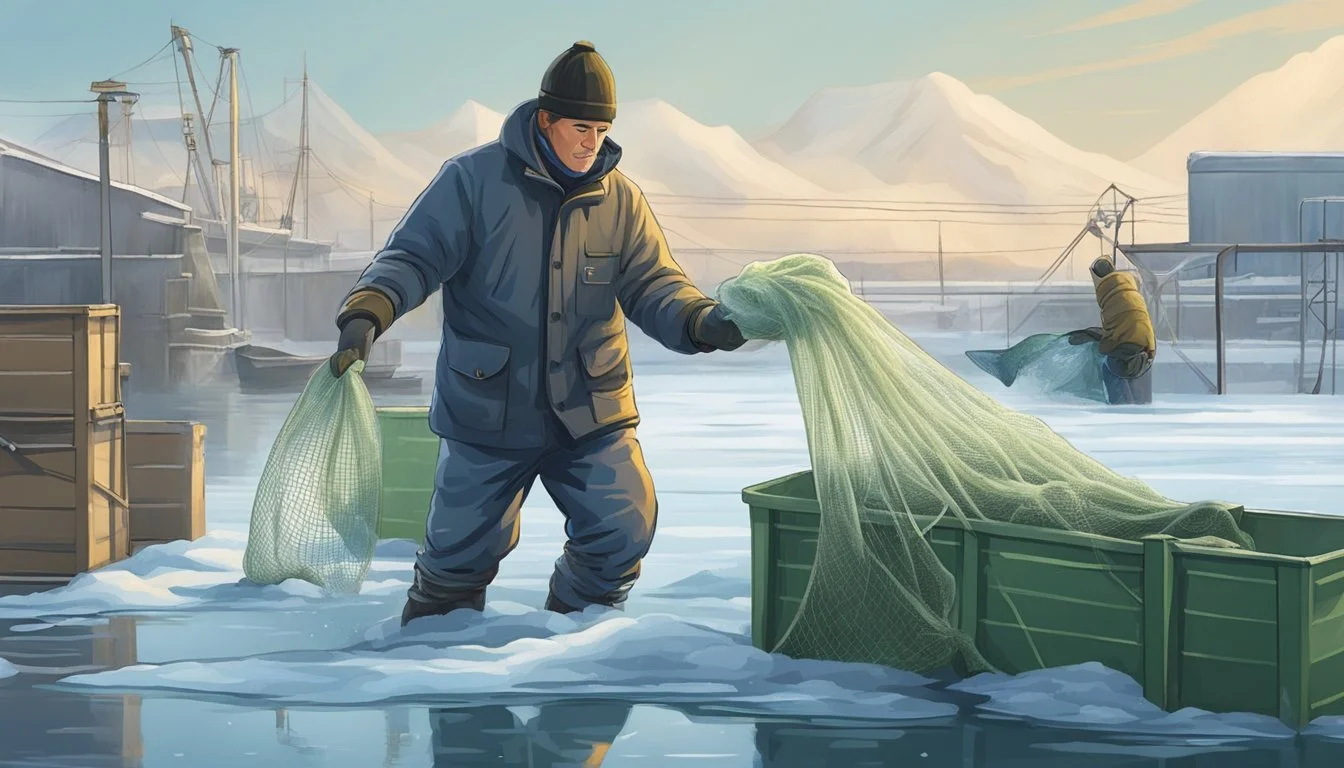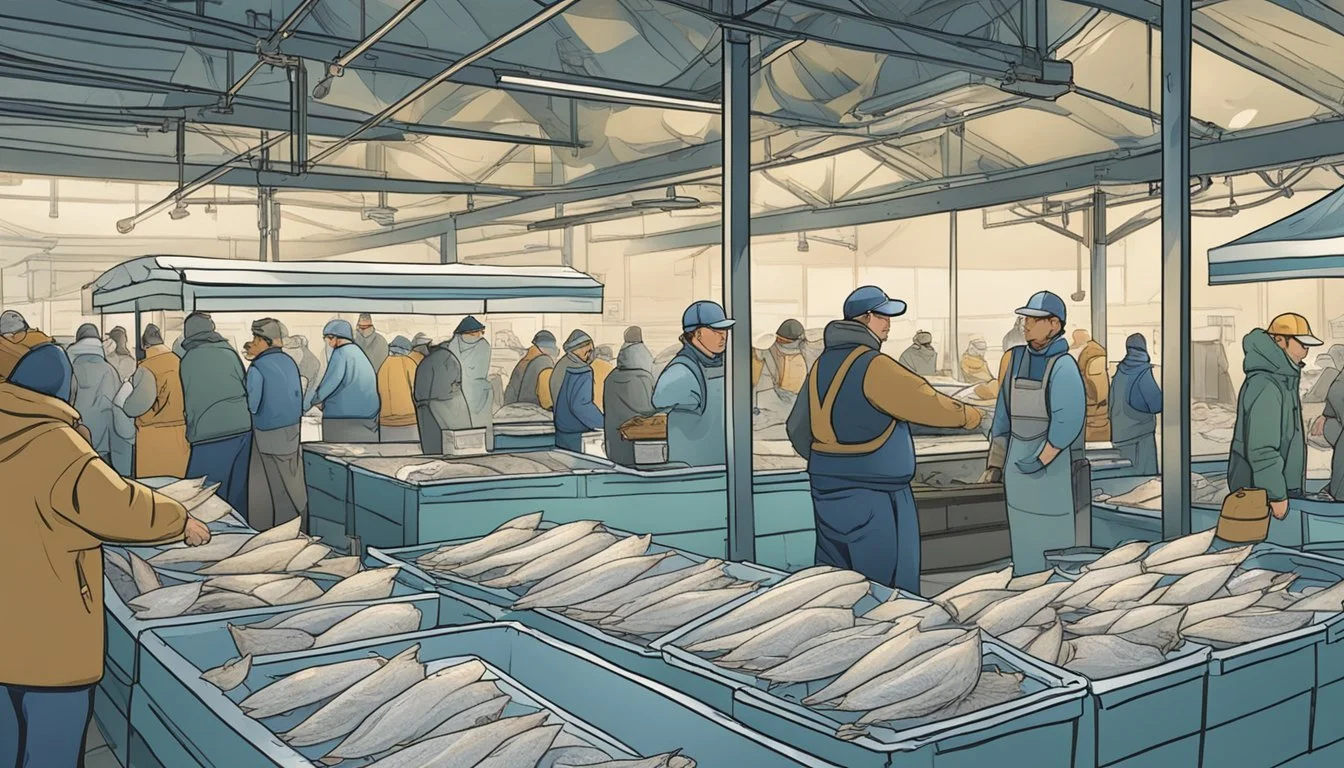Frozen vs Fresh Haddock: A Sea-to-Table Comparison
When it comes to choosing between frozen and fresh haddock, many seafood lovers face a dilemma. Both options have their merits, but the choice often depends on factors like availability, convenience, and personal preference.
Frozen haddock can be a better value and more convenient option for home cooks. It allows for easy portioning and reduces food waste, as consumers can use only what they need from the freezer. Frozen fish is often flash-frozen shortly after catch, preserving its quality and nutritional value.
Fresh haddock may offer a slightly superior flavor profile, but the difference is often minimal when the fish is cooked properly. The convenience and long shelf life of frozen haddock make it an attractive choice for many households. Ultimately, both frozen and fresh haddock can provide delicious and nutritious meals when prepared with care.
Understanding Haddock
Haddock is a popular white fish known for its mild flavor and flaky texture. It's an excellent source of lean protein and omega-3 fatty acids, making it a nutritious choice for many diets.
Fresh Haddock Identification
Fresh haddock has distinct characteristics that indicate its quality. The flesh should be firm and translucent with a slight pinkish tint. When pressed, it should spring back quickly. Fresh haddock has a mild, slightly sweet aroma without any strong fishy smell.
Look for clear, bulging eyes and bright red gills. The skin should be moist and shiny, with tightly adhering scales. Avoid haddock with discolored or dry patches, as these may indicate spoilage.
When cooked, fresh haddock turns opaque white throughout. It flakes easily with a fork, revealing a tender and moist interior.
Frozen Haddock Overview
Frozen haddock offers convenience and extended shelf life. It's typically flash-frozen shortly after catch, preserving its nutritional value and flavor. When properly stored at 0°F (-18°C) or below, frozen haddock can maintain its quality for up to 6 months.
To thaw frozen haddock, place it in the refrigerator overnight. Avoid thawing at room temperature, as this can promote bacterial growth. Once thawed, cook the fish within 24 hours for best results.
Frozen haddock can be cooked directly from frozen, though cooking times may need to be adjusted. Baking, grilling, or pan-frying are suitable methods for frozen haddock. Ensure the internal temperature reaches 145°F (63°C) for food safety.
Nutritional Value and Quality
Frozen and fresh haddock offer similar nutritional profiles, with some differences in quality preservation. Both provide lean protein and essential nutrients, though the freezing process can impact certain aspects.
Nutrition Content Comparison
Haddock is a nutritious fish, whether fresh or frozen. A 3.5-ounce serving of cooked haddock contains approximately 90 calories, 20 grams of protein, and less than 1 gram of fat. It's rich in omega-3 fatty acids, which support heart and brain health.
Frozen haddock retains most of its nutritional value. The freezing process doesn't significantly alter the protein or omega-3 content. However, some water-soluble vitamins may decrease slightly during freezing and thawing.
Fresh haddock might have a slight edge in vitamin content, particularly B vitamins. These nutrients are more stable in fresh fish that hasn't undergone freezing and thawing cycles.
Quality Preservation Through Freezing
Freezing technology has greatly improved, allowing frozen haddock to maintain high quality. Modern flash-freezing methods preserve the fish's texture and flavor effectively.
Frozen haddock can be stored for several months without significant quality loss. This extended shelf life reduces waste and allows for year-round availability.
Fresh haddock, while excellent when truly fresh, begins to deteriorate quickly. Its quality declines within days of catch, even when properly refrigerated.
Texture differences may be noticeable. Fresh haddock tends to have a slightly firmer texture, while properly thawed frozen haddock can be nearly indistinguishable in many recipes.
Culinary Aspects
Frozen and fresh haddock offer distinct culinary experiences, each with unique flavor profiles, textures, and cooking considerations. Understanding these differences is key to achieving optimal results in the kitchen.
Flavor Profiles
Frozen haddock tends to have a milder taste compared to its fresh counterpart. The freezing process can slightly mute the natural flavors. Fresh haddock boasts a cleaner, more pronounced seafood flavor with subtle sweet notes.
Properly frozen haddock maintains much of its original taste, especially when frozen quickly after catching. This preservation method locks in freshness, making it a reliable option year-round.
Fresh haddock shines with its delicate, slightly sweet flavor profile. It offers a pure taste of the sea, ideal for those who appreciate the nuances of fresh seafood.
Texture Differences
Fresh haddock typically has a firmer, more delicate texture. The flesh is moist and flakes easily when cooked properly. It retains its natural moisture content, resulting in a succulent eating experience.
Frozen haddock can sometimes be slightly less firm due to ice crystal formation during freezing. However, high-quality flash-frozen haddock often maintains a texture very close to fresh.
When thawed correctly, frozen haddock can still provide an excellent texture. Proper thawing in the refrigerator helps minimize moisture loss and texture changes.
Cooking Techniques for Haddock
Both fresh and frozen haddock respond well to various cooking methods. For baked haddock, preheat the oven to 400°F (200°C). Place the fillets in a greased baking dish and cook for 10-15 minutes per inch of thickness.
Pan-searing works excellently for both types. Heat oil in a pan over medium-high heat and cook for 3-4 minutes per side until golden brown and flaky.
Frozen haddock may require slightly longer cooking times. Always ensure the internal temperature reaches 145°F (63°C) for food safety.
Grilling fresh haddock brings out its natural flavors. For frozen fillets, thaw completely before grilling to ensure even cooking.
Poaching is gentle on both fresh and frozen haddock, helping to preserve moisture and delicate textures.
Preparation and Cooking
Properly preparing and cooking haddock ensures a delicious and safe meal. The methods differ slightly between fresh and frozen fish, but both can yield excellent results when handled correctly.
Thawing Process for Frozen Haddock
Thawing frozen haddock properly is crucial for food safety and texture. Place frozen fillets in the refrigerator overnight for slow, even thawing. For quicker results, seal the fish in a plastic bag and submerge it in cold water, changing the water every 30 minutes.
Never thaw fish at room temperature, as this can promote bacterial growth. Once thawed, pat the fillets dry with paper towels before cooking.
Baking Fresh vs Frozen Haddock
Baking is a popular method for cooking both fresh and frozen haddock. Preheat the oven to 400°F (200°C). For fresh haddock, place fillets on a lined baking sheet, drizzle with olive oil, and season as desired.
Frozen fillets can be baked directly without thawing. Place them on a lined baking sheet, brush with oil, and season. Bake fresh haddock for 12-15 minutes, while frozen fillets typically require 15-20 minutes.
Check for doneness by ensuring the fish flakes easily with a fork. Cooking times may vary based on fillet thickness.
Safe Cooking Temperatures
Ensuring haddock reaches a safe internal temperature is essential for food safety. Use a food thermometer to check that the thickest part of the fillet reaches 145°F (63°C).
At this temperature, the fish should be opaque and flake easily. If the fish hasn't reached this temperature, continue cooking in short intervals, checking frequently to avoid overcooking.
For added safety, let the cooked haddock rest for 3-5 minutes before serving. This allows the temperature to stabilize and ensures any remaining bacteria are eliminated.
Tips for Selecting and Storing
Selecting and storing haddock properly ensures optimal freshness and flavor. Proper techniques can extend shelf life and maintain quality whether buying fresh or frozen fish.
Choosing the Freshest Fish
Look for bright, clear eyes and shiny, moist skin when selecting fresh haddock. The flesh should be firm and spring back when pressed. Fresh fish should have a mild, ocean-like scent without any strong odors. When buying from a fishmonger, ask about the catch date and origin.
For frozen haddock, check the packaging for signs of freezer burn or ice crystals. Avoid packages with visible frost or discoloration. Look for vacuum-sealed or tightly wrapped fish to prevent moisture loss.
Best Practices for Storing Fish
Fresh haddock should be stored in the coldest part of the refrigerator at 32°F to 38°F. Use within 1-2 days for optimal quality. Wrap the fish tightly in plastic or store in an airtight container to prevent odors from spreading.
For longer storage, freeze haddock at 0°F or below. Wrap fish tightly in moisture-proof packaging to prevent freezer burn. Properly stored, frozen haddock can last up to 6 months.
When transporting fish, use an insulated cooler with ice packs to maintain temperature. Minimize time at room temperature to preserve freshness and prevent bacterial growth.
Comparative Cost and Value
Frozen and fresh haddock differ significantly in price and convenience. These factors play a crucial role in consumer decision-making when purchasing fish.
Price Consideration
Frozen haddock typically costs about 20% less than fresh haddock. This price difference stems from several factors. Frozen fish can be transported and stored more economically, reducing overall costs. Fresh haddock, being time-sensitive, requires faster and more expensive shipping methods.
Seasonal availability also impacts pricing. Fresh haddock prices may spike during peak demand periods or when fishing conditions are poor. Frozen haddock prices remain more stable year-round.
Farmed haddock, whether fresh or frozen, often has lower and more consistent pricing compared to wild-caught varieties.
Convenience Factor
Frozen haddock offers superior convenience for many consumers. It can be stored for months in a home freezer, allowing for bulk purchases and reducing shopping frequency. This long shelf life minimizes food waste, as consumers can use only what they need.
Fresh haddock requires prompt use, typically within 1-2 days of purchase. This time constraint may not suit all schedules or meal planning habits. Frozen haddock provides flexibility, allowing for last-minute meal decisions without sacrificing quality.
Pre-portioned frozen haddock fillets offer additional convenience, eliminating the need for handling and dividing larger pieces of fish.
Creative Recipe Ideas
Haddock's versatility shines through in innovative dishes that combine classic flavors with modern twists. From oven-baked delights to exciting alternatives, these recipes offer delicious ways to enjoy this flaky fish.
Baked Haddock Innovations
Parmesan-crusted haddock elevates the traditional baked recipe. Mix grated parmesan cheese with breadcrumbs and coat haddock fillets before baking. Drizzle melted butter and lemon juice over the top for added flavor.
For a Mediterranean twist, top haddock with sliced tomatoes, garlic, and herbs before baking. This light and fresh approach complements the fish's delicate taste.
Try a spicy version by adding cayenne pepper to the breadcrumb mixture. The heat pairs well with haddock's mild flavor, creating an exciting contrast.
Alternative Fish Recipes
Haddock fish cakes offer a creative way to use leftover fish. Mix flaked cooked haddock with mashed potatoes, herbs, and spices. Form into patties and pan-fry until golden brown.
Grilled haddock skewers present a fun twist on seafood kebabs. Cut haddock into chunks, thread onto skewers with vegetables, and brush with a citrus marinade before grilling.
For a comforting meal, prepare haddock chowder. Simmer chunks of haddock in a creamy broth with potatoes, corn, and bacon for a hearty soup perfect for cooler days.
Environmental and Ethical Considerations
The choice between frozen and fresh haddock extends beyond taste and convenience to environmental and ethical factors. Fishing practices and sustainability efforts play crucial roles in the seafood industry's impact on marine ecosystems.
Farmed vs Wild-Caught Haddock
Farmed haddock can offer advantages in terms of environmental control and reduced pressure on wild populations. These operations often implement strict monitoring of water quality and fish health.
Wild-caught haddock, when sourced responsibly, supports traditional fishing communities and can maintain ecosystem balance. However, overfishing remains a concern in some regions.
Seafood Watch rates some farmed cod operations as "green" when they demonstrate minimal impact on wild species and the environment. This rating system helps consumers make informed choices about sustainable seafood options.
Sustainability in the Seafood Industry
Sustainable fishing practices aim to maintain fish populations and protect marine habitats. These include catch limits, seasonal restrictions, and gear modifications to reduce bycatch.
Freezing fish allows for more environmentally friendly transportation methods. Frozen seafood can travel by boat, rail, or truck, using less energy compared to air-shipped fresh fish.
Some haddock fisheries have implemented improvements to minimize their environmental impact. These efforts focus on reducing damage to ocean floors and limiting the capture of non-target species.
Consumers can support sustainability by choosing seafood from well-managed fisheries. Look for certifications or ratings from reputable organizations when purchasing haddock or other seafood products.
The Social Aspect of Seafood
Seafood plays a significant role in social interactions and cultural traditions worldwide. It brings people together and has become a popular subject on social media platforms.
Community and Seafood Consumption
Seafood experiences often serve as social catalysts. Many cultures have long-standing traditions centered around fish and shellfish consumption. In coastal communities, seafood feasts are common events that strengthen social bonds.
Fishing itself is a social activity, with friends and families bonding over shared catches. Fish markets and seafood restaurants act as community gathering places. These venues foster connections between consumers, fishmongers, and chefs.
The cultural significance of seafood varies globally. In some regions, specific dishes hold deep symbolic meaning. For example, the Feast of the Seven Fishes is an Italian-American Christmas Eve tradition.
Seafood in Social Media
Social media has transformed how people engage with seafood. Instagram is particularly influential in shaping perceptions and trends. Users share visually appealing seafood dishes, influencing others' dining choices.
Food bloggers and chefs showcase innovative seafood preparations online. This exposure introduces followers to new species and cooking methods. Sustainability discussions also occur on these platforms, raising awareness about responsible consumption.
Seafood companies leverage social media for marketing. They share recipes, sourcing information, and behind-the-scenes content. This approach helps build brand loyalty and educates consumers about seafood products.








